Experimental Study on Fire Suppression of the Outdoor Oil-Immersed Transformer by High-Pressure Water Mist System
Abstract
:1. Introduction
2. Methodology
2.1. Design Principle
- The layout of the water mist nozzle is generally based on the rectangular shape.
- The emitted water mist should be evenly distributed to fill the protective space and completely shield the protected object.
- The working pressure P at the worst place must be no less than 10 MPa.
- The water spray intensity W must be no less than 1.2 L/(min·m2), and the water consumption should not be overdone.
- The flow discharge coefficient K should be within the design domain of the manufacturer.
2.2. Problem Analysis
2.3. Similarity Design
3. Experiment Platform
3.1. Platform Building
3.2. Experiment Procedure
3.3. Testing Scheme
4. Results and Discussion
4.1. Fire Suppression Process
4.2. The Temperature Curve of the Typical Test
4.3. The Impact Analysis of Ejecting Flow Rate on Fire Extinguishing Efficiency
4.4. The Impact Analysis of Nozzle Installation Height on Fire Extinguishing Efficiency
4.5. The Impact Analysis of Wind Speed on Fire Extinguishing Efficiency
5. Conclusions
- There were some defects in the design of the high-pressure water mist fire-extinguishing system for the small-scale transformer when using the routine national standards, such as the flow discharge coefficient K of the nozzle not meeting the requirement of the manufacturer. Therefore, the method of the similarity principle was proposed to construct a real-type test platform and conduct relevant experimental research. The design results fully met the national standard and manufacturer requirements.
- When the transformer fire entered a state of full combustion, the high-pressure water mist fire-extinguishing system was activated. The following phenomena could be observed: (i) After the water mist was sprayed, there was a deflagration phenomenon lasting about 2–4 s, which was influenced by a fresh supply of oxygen; at this moment, the flame temperature rose rapidly and then dropped sharply, and finally cooled to the indoor temperature; (ii) the closer to the nozzle, the sooner the oil pan fire was extinguished.
- Based on the current testing conditions, the influence of three main factors (the water flow rate, nozzle installation position and ambient wind speed) on the fire extinguishing efficiency of the high-pressure water mist system for the outdoor transformer fire is discussed. The results show that: (i) increasing the flow rate of the nozzle can effectively shorten the fire extinguishing time and significantly improve the performance of the high-pressure water mist system; (ii) the project team adjusted the upper nozzle height within the range of 1400 mm ≤ H1 ≤ 1800 mm and found that the fire extinguishing efficiency of the system was best at the height of 1800 m; (iii) the greater the ambient wind speed, the more disadvantageous the suppression effect of the high-pressure water mist system on the transformer fire.
- This paper has a positive significance in promoting the use of high-pressure water mist fire extinguishing systems for outdoor oil-immersed transformers. The main deficiency of this paper is the lack of repeatability tests due to the limitation of the test conditions. Therefore, there may be random errors in the final result, and the project’s team plans to conduct a larger experimental study.
Author Contributions
Funding
Institutional Review Board Statement
Informed Consent Statement
Data Availability Statement
Acknowledgments
Conflicts of Interest
References
- Li, J.; Zhu, H. Experiments on fire suppression of oil-filled transformer fire. Fire Sci. Technol. 2012, 31, 1306–1309. [Google Scholar] [CrossRef]
- El-Harbawi, M. Fire and Explosion Risks and Consequences in Electrical Substations—A Transformer Case Study. ASME Open J. Eng. 2022, 1, 014501. [Google Scholar] [CrossRef]
- Duarte, D. Aspects of Transformer Fires in Brazil. Open J. Saf. Sci. Technol. 2012, 3, 63–74. [Google Scholar] [CrossRef] [Green Version]
- Wang, H.; Chen, C.; Hu, L.; Wang, X. Reflection and Prevention of Transformer Fire Typical Case. Distrib. Util. 2018, 11, 78–82. [Google Scholar] [CrossRef]
- Ma, K.; Liu, W.; Chen, J.; Yang, X.; Zhang, Y. Experimental research on factors affecting fire suppression by oil discharge of oil-immersed power transformer. Ningxia Electr. Power 2020, 1, 33–37. [Google Scholar] [CrossRef]
- Zhao, J.; Yuan, J.; Tian, F.; Huang, H.; Yang, R. Initial fuel temperature effects on burning characteristics of transformer oil pool fire. CIESC J. 2020, 71, 3379–3386. [Google Scholar] [CrossRef]
- Wang, Y.; Li, C.; Zhang, J.; Shang, F.; Lu, S.; Fan, M.; Wang, L. Fire Accident Characteristics and Fire Extinguishing Countermeasures of Oil-Immersed Transformer. Saf. Environ. Eng. 2019, 26, 166–171. [Google Scholar]
- Zhao, Z.; Xu, Z.; Wang, J.; Guan, J.; Yu, X.; Li, G. Research on the Fire Safety of Large Power Transformer. High Volt. Eng. 2015, 41, 3378–3384. [Google Scholar] [CrossRef]
- Zhao, J.; Wang, S.; Zhang, J.; Zhou, R.; Yang, R. Experimental Study on the Burning Characteristics of Transformer Oil Pool Fires. Energy Fuels 2020, 34, 4967–4976. [Google Scholar] [CrossRef]
- Wang, Y.; Li, C.; Zhang, J.; Shang, F.; Lu, S.; Fan, M.; Wang, L. Empirical Study on the Combustion Characteristics of Insulating Oil in Typical Converter Transformers Based on Fire Propagation Apparatus. Saf. Environ. Eng. 2020, 1, 190–196. [Google Scholar] [CrossRef]
- Chen, T.; Zhao, L.; Fu, X.; Zhang, J.; Wang, Q.; Hu, C.; Bao, Z.; Li, B.; Li, G. Fire accident characteristics and firefighting solutions of large converter transformer. Fire Sci. Technol. 2020, 39, 1138–1141. [Google Scholar] [CrossRef]
- Zhang, B.; Zhang, J.; Yu, Z.; Chen, Q.; Fan, M. Effects of initial fuel temperature on combustion characteristics of transformer oil. Fire Sci. Technol. 2019, 38, 61–63. [Google Scholar] [CrossRef]
- Ji, J.; Chen, X.; Li, L.; Zhu, H.; Nie, J.; Han, Y. Fire Risk Assessment and Experimental Study of Transformer Insulating Oil. Adv. Civ. Eng. 2022, 2022, 7185045. [Google Scholar] [CrossRef]
- Chen, G.; Jing, W.; Wang, Z.; Xu, L.; Chen, P. Study on influence of fire source power on combustion characteristics of indoor transformer fire. J. Saf. Sci. Technol. 2019, 15, 186–192. [Google Scholar] [CrossRef]
- Kung, H.; Stavrianidis, P. Buoyant plumes of large-scale pool fires. Symp. Int. Combust. 1982, 19, 905–912. [Google Scholar] [CrossRef]
- Fan, M.; Li, W.; Du, X.; Qi, J.; Wang, S.; Wu, H. Experimental Study of Combustion Characteristics of a Typical Transformer Oil. East China Electr. Power 2013, 41, 1865–1870. [Google Scholar]
- Novozhilov, V.; Koseki, H. Cfd Prediction of Pool Fire Burning Rates and Flame Feedback. Combust. Sci. Technol. 2004, 176, 1283–1307. [Google Scholar] [CrossRef]
- Babrauskas, V. Estimating large pool fire burning rates. Fire Technol. 1983, 19, 251–261. [Google Scholar] [CrossRef]
- Chen, S.; Deng, J.; Ju, Z.; Wang, Z.; Chen, P.; Zhao, J. Experimental study on combustion laws of transformer oil pool fire. J. Saf. Sci. Technol. 2020, 16, 63–68. [Google Scholar] [CrossRef]
- Nakakuki, A. Heat transfer in small scale pool fires. Combust. Flame 1994, 96, 311–324. [Google Scholar] [CrossRef]
- Hayasaka, H. Unsteady burning rates of small pool fires. Fire Saf. Sci. 1997, 5, 499–510. [Google Scholar] [CrossRef] [Green Version]
- Zhang, B.; Zhang, J.; Huang, Y.; Wang, Q.; Yu, Z.; Fan, M. Burning process and fire characteristics of transformer oil. J. Therm. Anal. Calorim. 2020, 139, 1839–1848. [Google Scholar] [CrossRef]
- Degroote, E.; García Ybarra, P.L. Flame propagation over liquid alcohols. J. Therm. Anal. Calorim. 2005, 80, 541–548. [Google Scholar] [CrossRef]
- Chen, Q.; Jing, W.; Wei, C.; Chen, P. Study on the unsteady combustion characteristics of transformer oil pool fire. Fire Sci. Technol. 2021, 40, 1114–1117. [Google Scholar] [CrossRef]
- GB50229-2019; Standard for Design of Fire Protection for Fossil Fuel Power Plants and Substations. Ministry of Housing and Urban-Rural Development: Beijing, China, 2019.
- Chen, W.; Hu, S.; Tang, L.; Ou, Y.; Lv, J.; Wu, X.; Lu, L.; Peng, J. Research review on Transformer Fire Protection Technology. In Proceedings of the 2019 2nd International Conference of Green Buildings and Environmental Management (GBEM2019), Guiyang, China, 14–16 June 2019; Volume 310, p. 022022. [Google Scholar]
- Wu, C.; Zhou, T.; Chen, B.; Liu, Y.; Liang, P. Experimental Study on Burning Characteristics of the Large-Scale Transformer Oil Pool Fire with Different Extinguishing Methods. Fire Technol. 2021, 57, 461–481. [Google Scholar] [CrossRef]
- Liu, Y.; Li, B.; Wu, C.; Chen, B.; Pan, B. Effectiveness Test and Evaluation of Transformer Fire Extinguishing System. Fire Technol. 2022, 58, 3167–3190. [Google Scholar] [CrossRef]
- Xu, C. Application of Water Spray Fire Extinguishing System in Substation Engineering. Henan Sci. Technol. 2020, 39, 93–96. [Google Scholar] [CrossRef]
- Chen, W. Design of Water Spray Fire Extinguishing System for Oil-Immersed Power Transformers. Nonferrous Metals Eng. Res. 2008, 29, 32–34. [Google Scholar] [CrossRef]
- Tu, J.; Pau, D.; Yang, T.; Nan, S.; Zhang, J.; Shang, F.; Li, K. Effect of foam air mixing on flame intensification—Comparative experimental study of foam and water sprays extinguishing transformer oil pool fire. Fire Saf. J. 2022, 133, 103664. [Google Scholar] [CrossRef]
- Zhu, X.L.; Chen, G.; Wang, Z.G.; Wu, L.S.; Luo, J.F.; Wang, X.S. Extinguishment of a transformer fire with a long projection water mist system. Fire Saf. J. 2022, 130, 103603. [Google Scholar] [CrossRef]
- Yusoff, Y.; Mohd-Lair, N.; Tsen, M.; Harman, M. Case study on Designing a Comprehensive Fire Protection System for KY Power Station. In Proceedings of the 2nd Joint International Conference on Emerging Computing Technology and Sports (JICETS), Bandung, Indonesia, 25–27 November 2019; Volume 1529, p. 032098. [Google Scholar]
- Ghadge, S.V.; Shingare, S.S. Nitrogen Injection Fire Prevention System for Oil Filled Transformers. Int. J. Adv. Res. Innov. Ideas Educ. 2016, 2, 569–578. [Google Scholar] [CrossRef]
- Wei, D.; Li, S.; Wu, X.; Song, Y.; Tan, R. Design of electromagnetic compatibility test platform for transformer fire-fighting nitrogen injection extinguishing system. In Proceedings of the 3rd International Conference on Environmental Prevention and Pollution Control Technologies, Zhuhai, China, 15–17 January 2021; Volume 687, p. 012121. [Google Scholar]
- Liu, M.; Liu, Y.; Sun, H.; Hu, J.; Wang, X. Experimental study on the interaction of water mist spray with two buoyant non-premixed flames. Process Saf. Environ. Prot. 2022, 161, 1–12. [Google Scholar] [CrossRef]
- Pao, F. Study on Simulation Modeling and Experimental of High Pressure Water Mist Fire Extinguishing System. Master’s Thesis, Beijing University of Civil Engineering and Architecture, Beijing, China, 2017. [Google Scholar]
- NFPA 750; Standard on Water Mist Fire Protection Systems. National Fire Protection Association: Quincy, MA, USA, 2019.
- Liu, Q.; Yi, X.; Lv, Z.; Zhang, Z. Progress on water mist fire suppression effectiveness. Sci. Technol. Eng. 2019, 22, 11–19. [Google Scholar] [CrossRef]
- DB J41/T074-2013; Code for Design, Installation and Acceptance of Water Mist Fire Protection System. Zhengzhou University Press: Zhengzhou, China, 2013.
- Liu, T.; Yin, X.; Liu, Y.; Tang, Y.; Huang, A.; Dong, X.L.; Liu, Y. Influence of Water Mist Temperature Approach on Fire Extinguishing Effect of Different Pool Fires. Processes 2022, 8, 1549. [Google Scholar] [CrossRef]
- GB 50898-2013; Technical Code for Water Mist Fire Extinguishing System. China Planning Press: Beijing, China, 2015.
- Yang, P.; Liu, T.; Qin, X. Experimental and numerical study on water mist suppression system on room fire. Build. Environ. 2010, 45, 2309–2316. [Google Scholar] [CrossRef]
- Bellas, R.; Gómez, M.A.; González-Gil, A.; Porteiro, J.; Míguez, J.L. Assessment of the Fire Dynamics Simulator for Modeling Fire Suppression in Engine Rooms of Ships with Low-Pressure Water Mist. Fire Technol. 2020, 56, 1315–1352. [Google Scholar] [CrossRef]
- Qin, Y.; Xu, Z. Analysis and Application of High Pressure Water Mist Fire Extinguishing System in Offshore Substation. South. Energy Constr. 2022, 9, 52–57. [Google Scholar] [CrossRef]
- Yu, H. Froude-modeling-based general scaling relationships for fire suppression by water sprays. Fire Saf. J. 2012, 47, 1–7. [Google Scholar] [CrossRef]
- Heskestad, G. Scaling the interaction of water sprays and flames. Fire Saf. J. 2002, 37, 535–548. [Google Scholar] [CrossRef]
- Liu, Z.; He, H.; Li, H.; Zhao, L.; Xu, Y. Full-scale authentic combustion room design and its scaling model in case of the ship passenger cabin fire. J. Saf. Environ. 2018, 18, 940–945. [Google Scholar] [CrossRef]
- Wang, J.; Tu, R.; Zeng, Y.; Zhang, Y. Design and Validity analysis of the scaling model and the fire detection standard combustion room. J. Saf. Environ. 2011, 6, 181–184. [Google Scholar] [CrossRef]
- Liu, H.; Lu, S.; Xu, S. Similarity model design and analysis of fires in ship machinery cabin. J. Therm. Sci. Technol. 2005, 4, 367–372. [Google Scholar] [CrossRef]
- Shi, C.; Liu, W.; Hong, W.; Zhong, M.; Zhang, X. A modified thermal radiation model with multiple factors for investigating temperature rise around pool fire. J. Hazard. Mater. 2019, 379, 120801. [Google Scholar] [CrossRef] [PubMed]

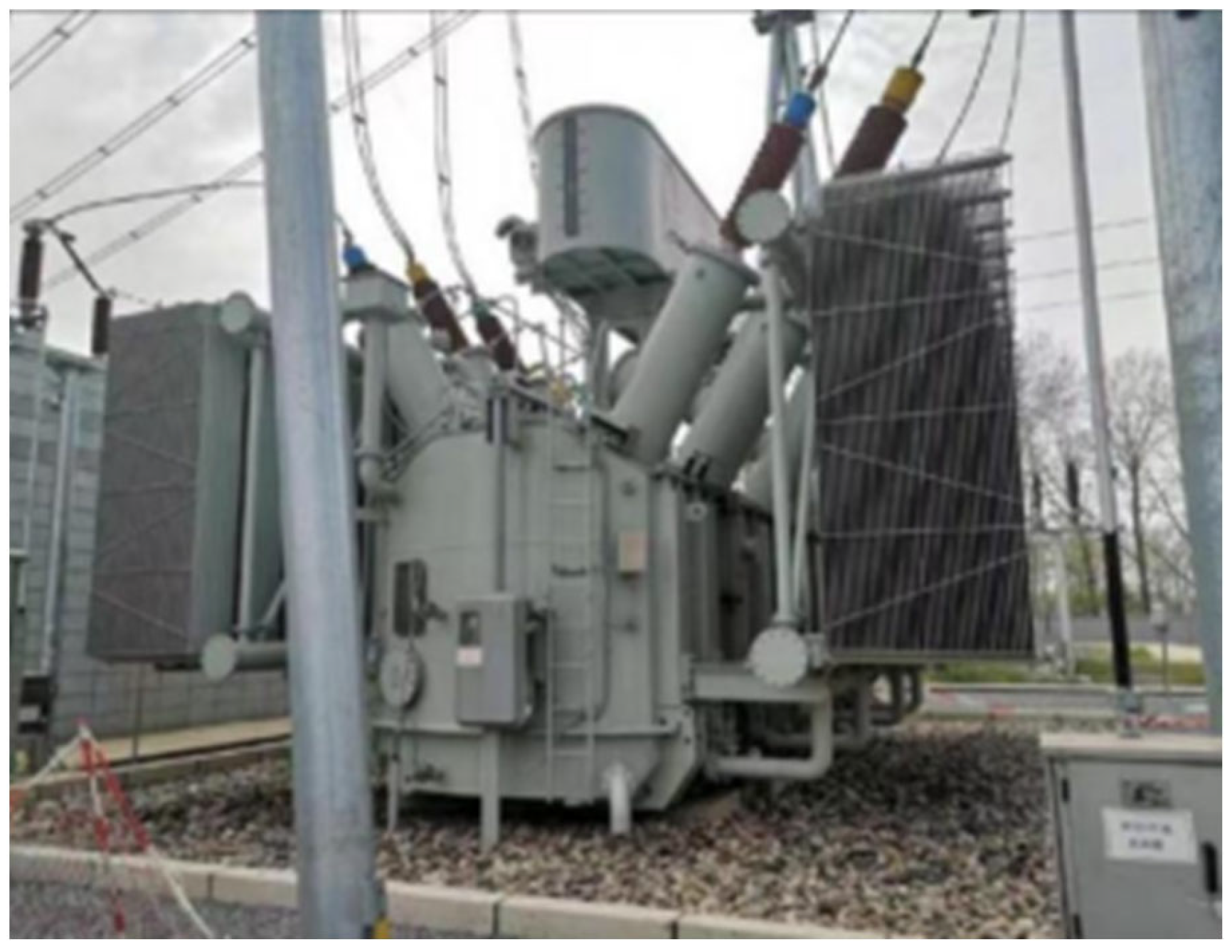


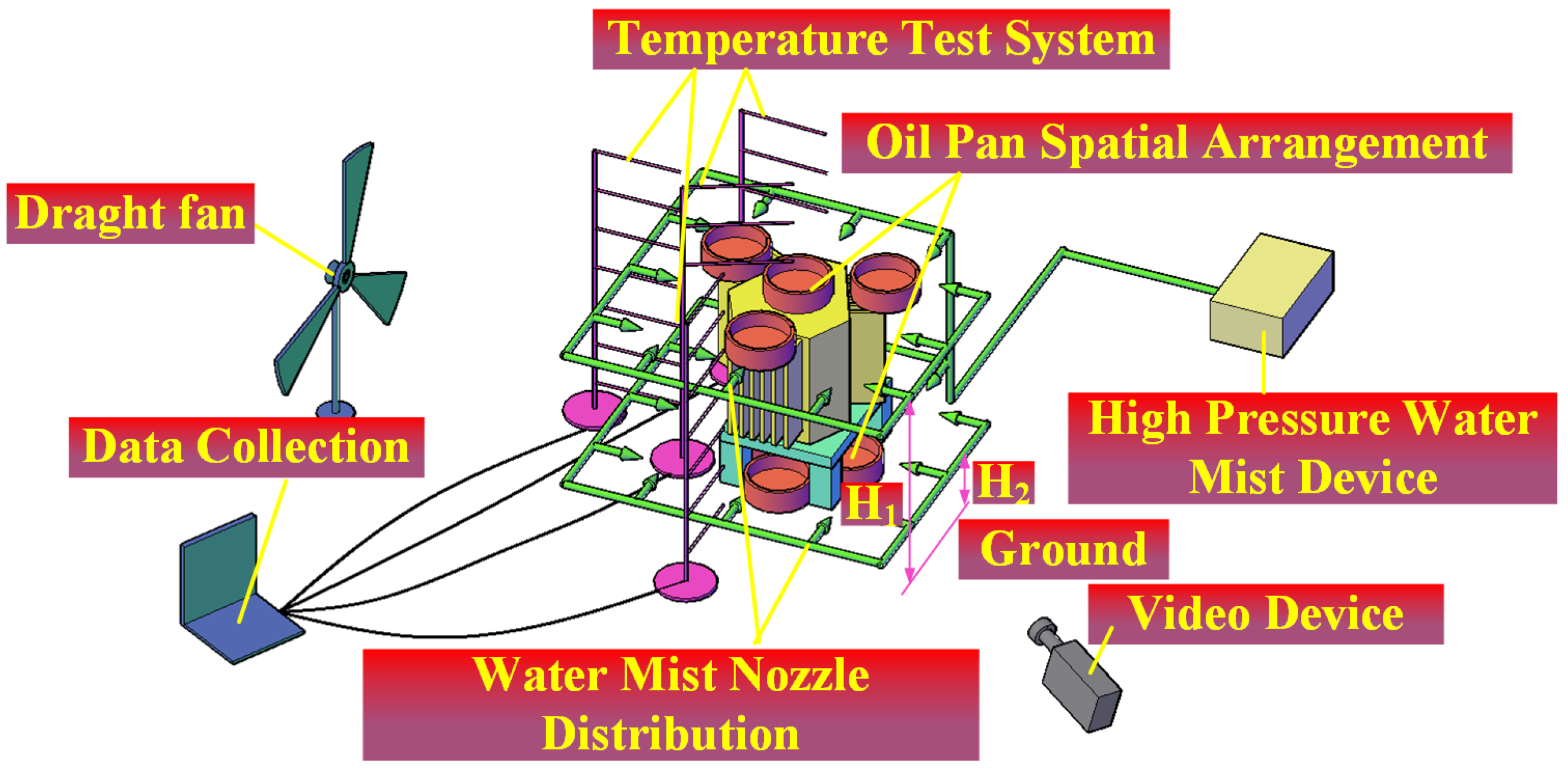
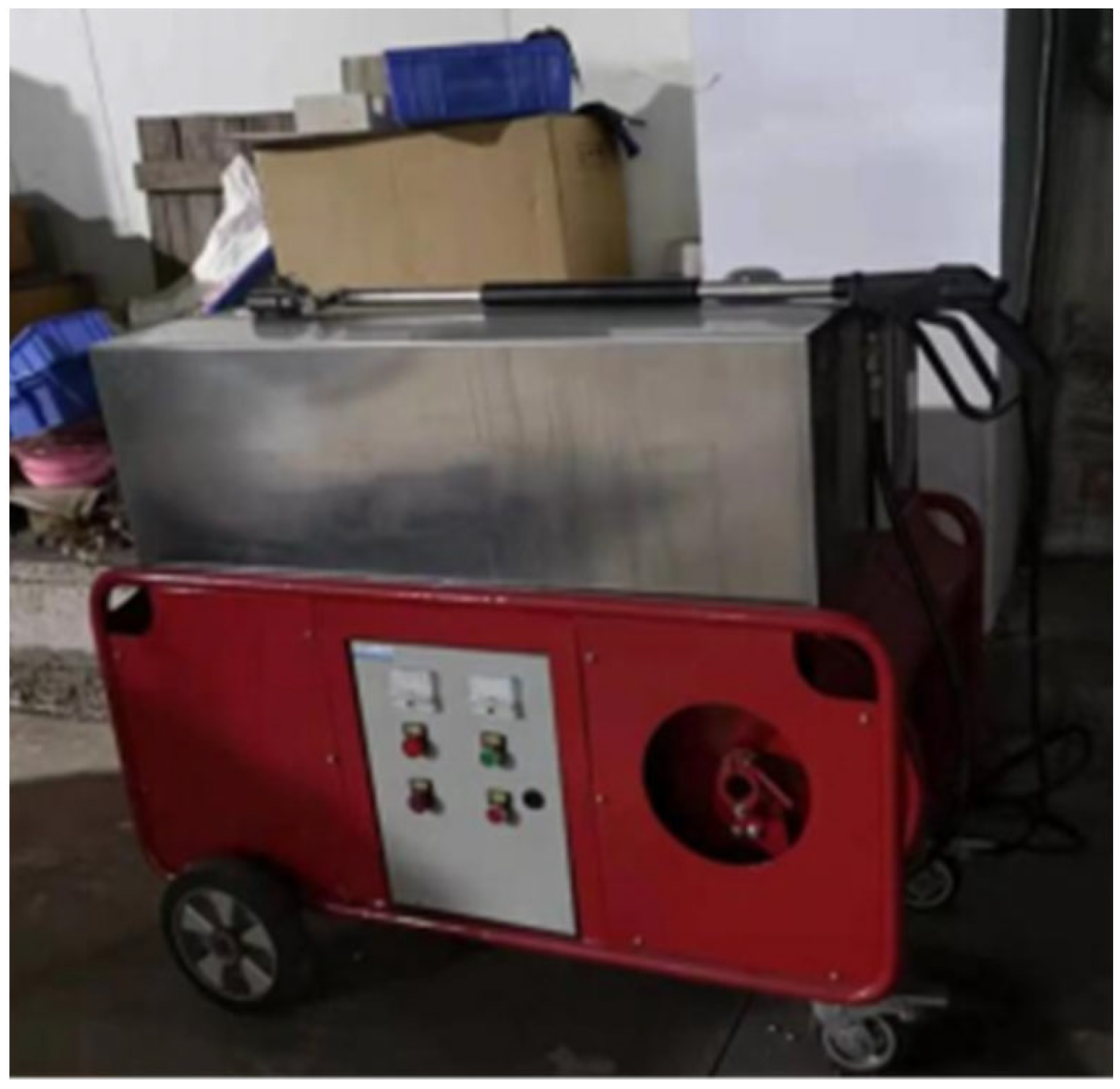
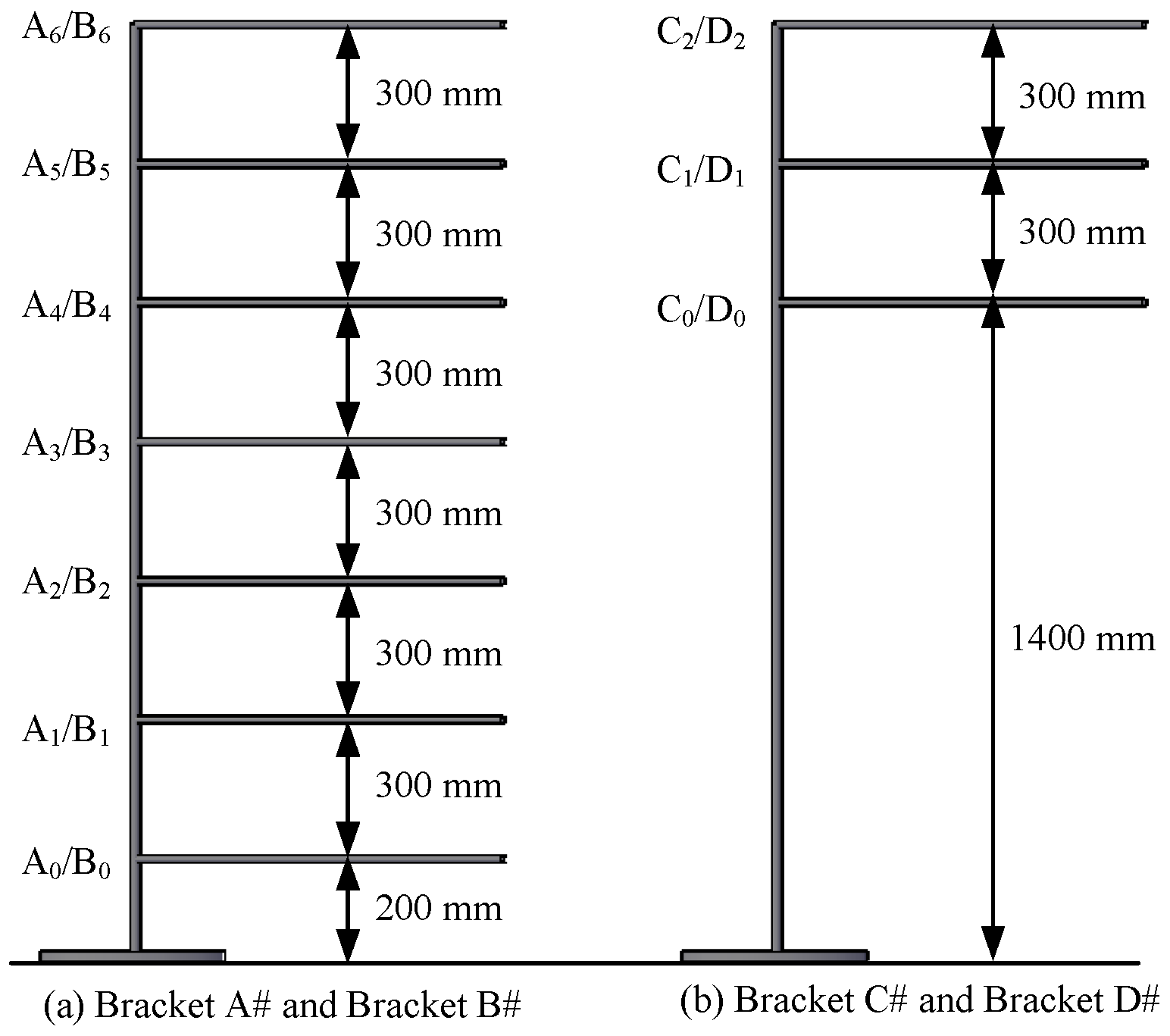
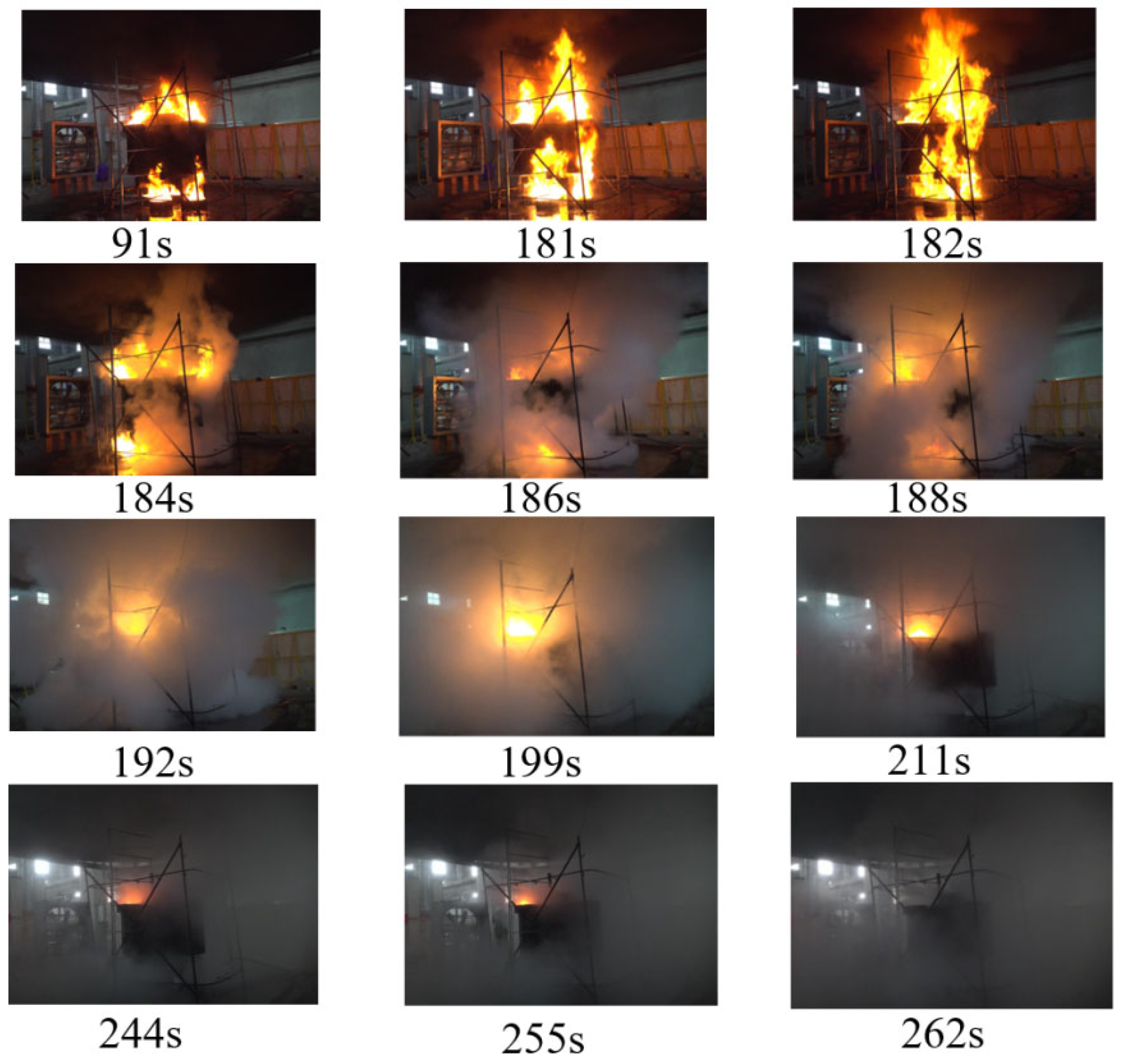
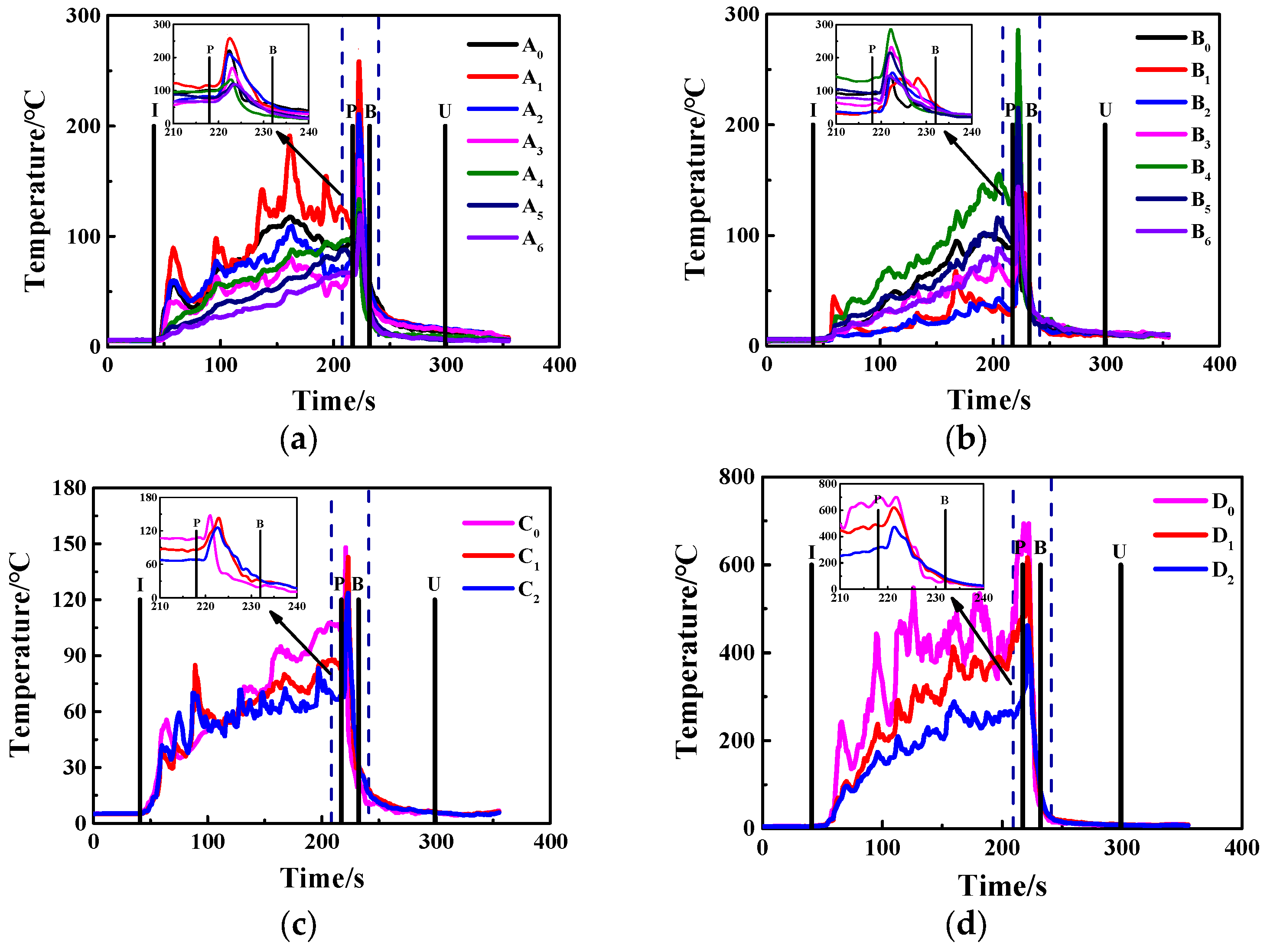

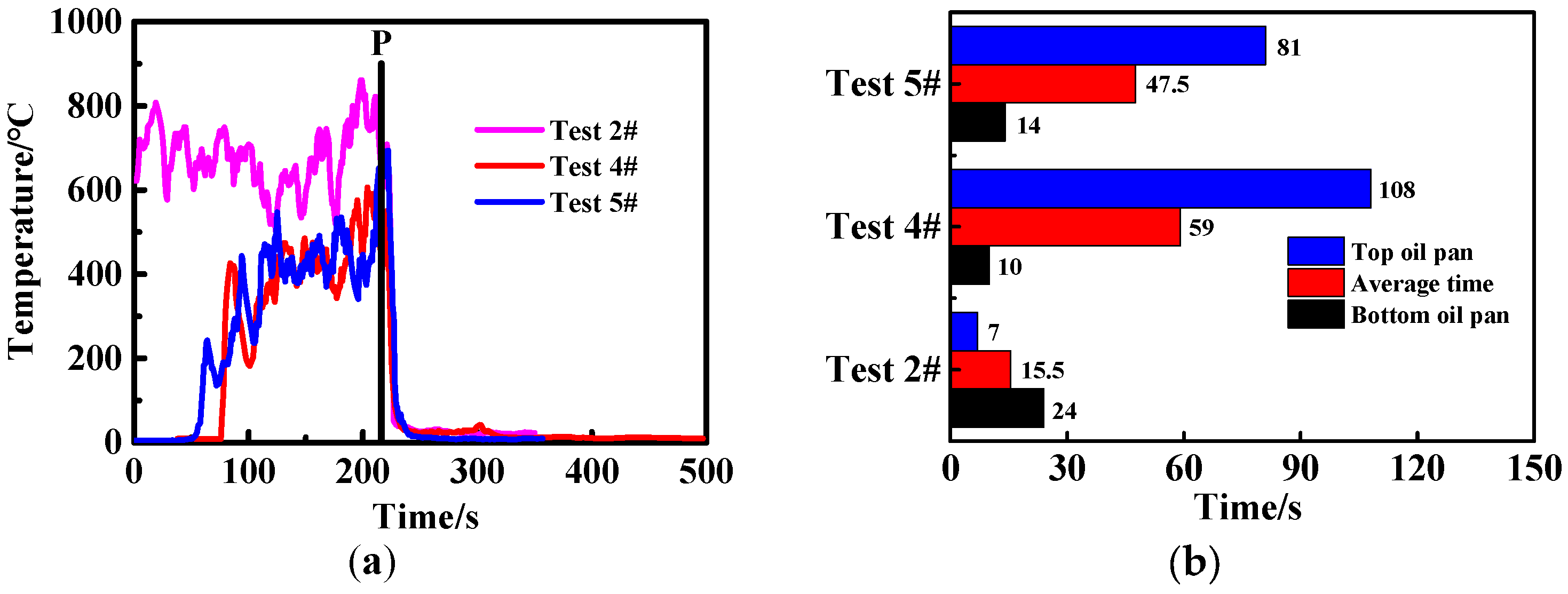

| Items | Similar Relation | Proportional Coefficient | Prototype | Model |
|---|---|---|---|---|
| Boundary geometry of the transformer (mm) | lm/lf = C | 4 | 4000 | 1000 |
| Water flow rate of a single nozzle (L/min) | Qm/Qf = C5/2 | 32 | 10 | 0.3125 |
| Horizontal spacing between nozzles (mm) | dm/df = C | 4 | 2500 | 625 |
| Vertical interval between layers (mm) | hm/hf = C | 4 | 4000 | 1000 |
| Distance from the nozzle to the transformer (mm) | Lm/Lf = C1/2 | 2 | 1500 | 750 |
| Height from the top nozzle to the ground (mm) | Hm/Hf = C | 4 | 6800 | 1700 |
| System Pressure (MPa) | K Factor (L/min/MPa0.5) | Flow Rate of a Nozzle (L/min) | Number of Nozzles | Water Spray Intensity (L/min·m2) |
|---|---|---|---|---|
| 15 | 0.03 | 0.367 | 24 | 1.746 |
| 15 | 0.06 | 0.735 | 24 | 3.492 |
| 15 | 0.03 | 0.367 | 16 | 1.164 |
| 15 | 0.06 | 0.735 | 16 | 2.328 |
| Density (kg/m3) | Kinematic Viscosity (mm2/s) | Point of Flammability (°C) | Gasoline (mL) | Transformer oil (mL) | Water (mL) |
|---|---|---|---|---|---|
| 882.8 | 9.4 | 155.5 | 5 | 500 | 4000 |
| No. | Upper Nozzle Height (mm) | Air Speed (m/s) | K Factor (L/min/MPa0.5) | Total Nozzles Number | Oil Pans 5#–8# (s) | Oil Pans 1#–4# (s) | Average Extinguishing Time (s) |
|---|---|---|---|---|---|---|---|
| 1 | 1800 | 0 | 0.03 | 24 | 152 | 204 | 178 |
| 2 | 1800 | 0 | 0.06 | 24 | 24 | 7 | 15.5 |
| 3 | 1800 | 0 | 0.06 | 16 | 72 | 104 | 88 |
| 4 | 1600 | 0 | 0.06 | 24 | 10 | 108 | 59 |
| 5 | 1400 | 0 | 0.06 | 24 | 14 | 81 | 47.5 |
| 6 | 1400 | 0.5 | 0.06 | 24 | 55 | 79 | 67 |
| 7 | 1400 | 1 | 0.06 | 24 | 50 | 106 | 78 |
| 8 | 1400 | 2 | 0.06 | 24 | 89 | 76 | 82.5 |
| 9 | 1400 | 0 | 0.06 | 16 | 33 | 165 | 99 |
| 10 | 1400 | 0 | 0.03 | 16 | 62 | 249 | 155.5 |
| 11 | 1400 | 0 | 0.03 | 24 | 38 | 68 | 53 |
Disclaimer/Publisher’s Note: The statements, opinions and data contained in all publications are solely those of the individual author(s) and contributor(s) and not of MDPI and/or the editor(s). MDPI and/or the editor(s) disclaim responsibility for any injury to people or property resulting from any ideas, methods, instructions or products referred to in the content. |
© 2023 by the authors. Licensee MDPI, Basel, Switzerland. This article is an open access article distributed under the terms and conditions of the Creative Commons Attribution (CC BY) license (https://creativecommons.org/licenses/by/4.0/).
Share and Cite
Song, H.; Yao, H.; Wei, X.; Qin, H.; Li, Y.; Lv, K.; Chen, Q. Experimental Study on Fire Suppression of the Outdoor Oil-Immersed Transformer by High-Pressure Water Mist System. Fire 2023, 6, 238. https://doi.org/10.3390/fire6060238
Song H, Yao H, Wei X, Qin H, Li Y, Lv K, Chen Q. Experimental Study on Fire Suppression of the Outdoor Oil-Immersed Transformer by High-Pressure Water Mist System. Fire. 2023; 6(6):238. https://doi.org/10.3390/fire6060238
Chicago/Turabian StyleSong, Huaitao, Haowei Yao, Xiaoge Wei, Hengjie Qin, Youxin Li, Kefeng Lv, and Qianlong Chen. 2023. "Experimental Study on Fire Suppression of the Outdoor Oil-Immersed Transformer by High-Pressure Water Mist System" Fire 6, no. 6: 238. https://doi.org/10.3390/fire6060238






